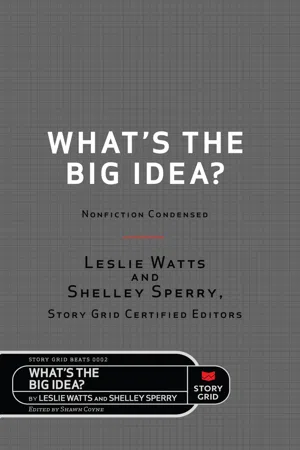

- English
- ePUB (mobile friendly)
- Available on iOS & Android
About this book
Undertaking any big project, but especially a book is a daunting proposition. The way to make it less scary is to have a map for the journey, and ideally, some experienced fellow travelers to ride shotgun—friends who know the road well and can help you make it to your destination. That’s what we are aiming to provide.
We’re two editors with over twenty years of experience between us, writing and editing many types of nonfiction. In the pages that follow, we distill some of the lessons we’ve learned in the trenches applying Shawn Coyne’s Story Grid methodology to the work of our clients, all of whom are leveling up their skills as nonfiction writers.
We’ve chosen to use several masterworks—with the most considerable emphasis on The Fire Next Time by James Baldwin and In Defense of Food by Michael Pollan—as the maps to guide us throughout What’s the Big Idea?
Although Baldwin and Pollan write on different topics and in different styles over half a century apart, both men had an enormous cultural impact. They extended that influence to a broad popular audience with these works. We could have chosen many other titles, and we’ll include examples from some others where it’s helpful.
After reading this short, macro-principles primer, you may want to take a microscopic dive into Big Idea nonfiction by looking at The Story Grid Masterwork Guide to Malcolm Gladwell’s The Tipping Point, which provides a scene-by-scene analysis of another exemplary title. We hope you’ll be inspired to find your own favorite masterworks to learn from and apply Story Grid Methodology yourself. We’ll provide some tips on how to do that too.
With Baldwin and Pollan as our touchstones, we’ve organized this book around a series of questions and answers that will explain how and why Big Idea books work.
Frequently asked questions
- Essential is ideal for learners and professionals who enjoy exploring a wide range of subjects. Access the Essential Library with 800,000+ trusted titles and best-sellers across business, personal growth, and the humanities. Includes unlimited reading time and Standard Read Aloud voice.
- Complete: Perfect for advanced learners and researchers needing full, unrestricted access. Unlock 1.4M+ books across hundreds of subjects, including academic and specialized titles. The Complete Plan also includes advanced features like Premium Read Aloud and Research Assistant.
Please note we cannot support devices running on iOS 13 and Android 7 or earlier. Learn more about using the app.
Information
HOW DO I KNOW IF I’M WRITING BIG IDEA NONFICTION?

ACADEMIC NONFICTION
NARRATIVE NONFICTION
HOW-TO NONFICTION
BIG IDEAS + COGNITIVE SCIENCE
Table of contents
- Cover
- Contents
- THE TRUTH IS
- WELCOME TO THE STORY GRID UNIVERSE. HERE'S HOW WE CONTEND WITH THOSE TRUTHS:
- Title Page
- Copyright
- BLANK
- Dedication
- Introduction
- 1. HOW DO I KNOW IF I’M WRITING BIG IDEA NONFICTION?
- 2. ACADEMIC NONFICTION
- 3. NARRATIVE NONFICTION
- 4. HOW-TO NONFICTION
- 5. BIG IDEAS + COGNITIVE SCIENCE
- 6. BUILDING THE BIG IDEA
- 7. WHAT’S THE BIG IDEA OF A BIG IDEA BOOK?
- 8. WHAT LIFE VALUE IS AT STAKE IN A BIG IDEA BOOK?
- 9. WHAT IS THE MACRO STRUCTURE OF A BIG IDEA BOOK?
- 10. HOW DO I SATISFY THE EXPECTATIONS OF THE BIG IDEA BOOK AUDIENCE?
- 11. CONVENTIONS OF BIG IDEA NONFICTION
- 12. OBLIGATORY SCENES OF BIG IDEA NONFICTION
- 13. HOW TO BUILD SCENES IN BIG IDEA NONFICTION
- 14. HOW TO FIGURE OUT WHAT KIND OF NONFICTION BEST SERVES YOUR IDEA
- 15. ARE YOU READY TO SHOW UP? ARE YOU READY TO MAKE MISTAKES?
- 16. RESOLUTION
- About the Authors
- Notes